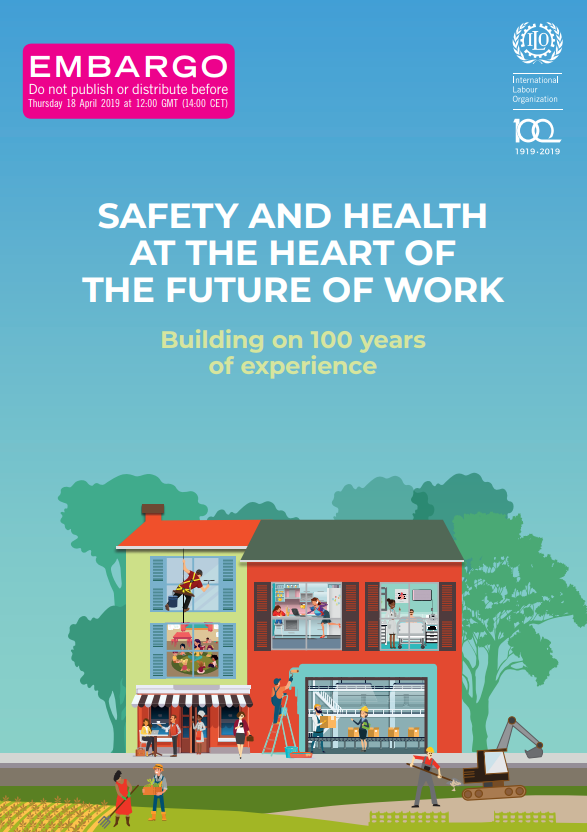
Safety and Health at the heart of the Future of Work: Building on 100 years of experience
Geneva (ILO 18 April 2019)
Changes in working practices, demographics, technology and the environment are creating new occupational safety and health (OSH) concerns, according to a new report from the International Labour Organization (ILO).
Growing challenges include psychosocial risks, work-related stress and non-communicable diseases, notably circulatory and respiratory diseases, and cancers.
The report, Safety and Health at the heart of the Future of Work: Building on 100 years of experience * , is being published ahead of the World Day for Safety and Health at Work , which is marked on April 28th. It reviews the ILO’s 100 years of work on OSH issues, and highlights emerging health and safety issues in the world of work.
Currently, more than 374 million people are injured or made ill every year through work-related accidents. It is estimated that work days lost to OSH-related causes represent almost 4 per cent of global GDP, in some countries as much as 6 per cent, the Report says.
“As well as more effective prevention for established risks, we are seeing profound changes in our places and ways of working. We need safety and health structures that reflect this, alongside a general culture of prevention that creates shared responsibility,” said Manal Azzi, ILO Technical Specialist on Occupational Safety and Health.
“As well as the economic cost we must recognize the immeasurable human suffering such illnesses and accidents cause. These are all-the-more tragic because they are largely preventable."
Looking to the future, the report highlights four major transformative forces driving changes. It points out that all also offer opportunities for improvements.
First, technology, such as digitization, robotics, and nanotechology, can also affect psychosocial health and introduce new materials with unmeasured health hazards. Correctly applied it can also help reduce hazardous exposures, facilitate training and labour inspections.
Demographic shifts are important because young workers have significantly high occupational injury rates, while older workers need adaptive practices and equipment to work safely. Women – who are entering the workforce in increasing numbers – are more likely to have non-standard work arrangements and have a higher risk of musculoskeletal disorders.
Thirdly, development and climate change give rise to risks such as air pollution, heat stress, emerging diseases, shifting weather and temperature patterns that can bring job losses. Equally, new jobs will be created through sustainable development and the green economy.
Finally, changes in the organization of work can bring flexibility that allows more people to enter the labour force, but may also lead to psychosocial issues (for example, insecurity, compromised privacy and rest time, or inadequate OSH and social protections) and excessive work hours. Approximately 36 per cent of the world’s workforce currently works excessive hours (more than 48 hours per week).
________
Table of contents
Introduction
Global trends in safety and health: The picture today
Chapter 1: 100 years of safety and health at work
1. Why the world needed to respond to accidents and diseases at work 100 years ago
2. The ILO: Founded on the concept of safe and healthy work
3. Post-Second World War: An increasingly global perspective on OSH
4. Towards a culture of prevention
5. ILO and safety and health at work in the new millennium
Chapter 2:
A safe and healthy future of work: Challenges and opportunities
2.1 Technology
Digitalization and ICT
Automation and robotics
Nanotechnology
2.2 Demographics
Young workers
Aging worker populations
Gender
Migrant workers
2.3 Sustainable development and OSH
Climate change, air pollution and environmental degradation
The green economy
ILO instruments in relation to climate change, sustainable development and OSH
2.4 Changes in work organization
Excessive hours of work
Non-standard forms of employment
Working time arrangements
The informal economy
The example of digital labour platforms
Chapter 3:
Responding to the safety and health challenges and
opportunities of the future of work
3.1 Anticipation of new OSH risks
3.2 Multidisiplinarity in managing OSH
3.3 Building competence on OSH
3.4 Widening the horizon: The link to public health
3.5 International labour standards and other instruments on OSH
National OSH legislation and management
Governance of OSH
3.6 Reinforcing the role of governments and social partners and expanding partnerships
Concluding remarks
References
...
Fonte: ILO
Allegati
|
Descrizione |
Lingua |
Dimensioni |
Downloads |
 |
|
EN |
7036 kB |
1197 |


































